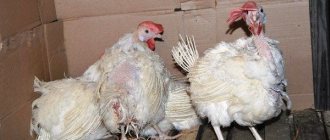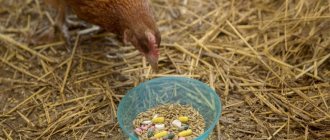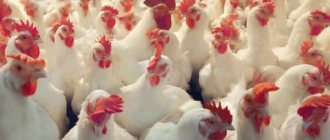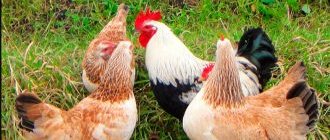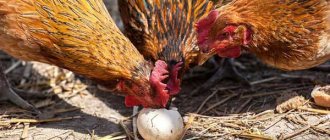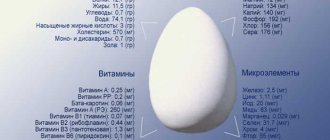Sneezing and coughing in chickens, or any other unnatural sounds may indicate the occurrence of any disease: from a cold to tuberculosis. Each of them can cause sudden epidemics. And as a result - mass mortality of birds. Therefore, it is important to detect the disease promptly and get rid of it as soon as possible. Next, we'll find out why chickens wheeze or cough, and what to do to cure them.
Unnatural sounds
Wheezing, coughing, sneezing, whistling, gurgling and bubbling in the throat are noises that occur when air moves in the bronchi and adjacent cavities.
In normal condition, noisy sounds are not characteristic of chickens. They appear in pathologies caused by narrowing of the airways. And also the presence of obstacles in the path of air flow: liquid sputum, blood, foreign bodies.
Therefore, wheezing and other unusual sounds in chickens are important symptoms indicating the development of diseases.
Let us describe common pathologies.
Cold
Not a dangerous disease. But if left untreated, it can lead to serious complications.
Causes of colds in chickens: hypothermia in an insufficiently insulated chicken coop, drafts, dampness, cold wind and sub-zero temperatures.
The disease progresses quickly. The nasopharynx becomes inflamed, the mucous membrane of the throat swells. Snot flows from its beak. The chicken wheezes, breathes heavily and frequently through its mouth. The eyes become cloudy and conjunctivitis develops.
Gradually the symptoms intensify. Chickens cough and sneeze, lose their appetite, and become lethargic. In the absence of therapy, a runny nose, whistling and wheezing intensify. To make breathing easier, the chicken constantly opens its beak and lifts its head.
Pneumonia
Pneumonia is a very dangerous pathology of the respiratory system, which also causes wheezing in the lungs. It poses quite a danger to young chickens (15-20 days from birth); in adult birds it is diagnosed relatively rarely.
The reasons for the development of pneumonia are different: it can be hypothermia, which is very typical for areas with a cold and damp climate, a draft in the poultry house, or unsanitary conditions of maintenance and care. During pneumonia, chickens' lung tissue and pleura are affected; over time, the disease begins to irritate the airways, which causes wheezing during breathing.
The sick bird begins to breathe heavily and frequently, and moist rales can be heard from a distance. Often accompanied by a runny nose, cough, lack of appetite and decreased activity.
In the absence of treatment, the affected young animals begin to die (mortality begins on the 2-3rd day). This disease can be identified by all the listed symptoms and by checking the conditions in which they are contained.
Infectious bronchitis (IB)
Characteristic
A disease that affects the respiratory system, kidneys, small intestine and reproductive organs of chickens.
The causative agent of the disease is coronavirus. Resistant to digestive enzymes, antibiotics and antibacterial drugs. Once in the body, the infection remains in the carrier for up to 1 year.
Virus carrier: sick, recovered bird or eggs of any of them.
The chicken sneezes or coughs, spreading the virus around. Other transmission routes:
- through bowel movements or vomit;
- upon contact with an infected individual;
- during sexual contact with a rooster.
The most susceptible to the virus are broilers and chickens up to 4 weeks old (mortality rate up to 40%), laying hens 5-6 months old (death rate up to 5%), adult chickens practically do not die.
The virus is not transmitted from a sick bird to other domestic animals. Just like a person.
Symptoms
The disease is diagnosed by a runny nose, lack of appetite and lethargy in birds. Chickens sneeze and wheeze, they are tormented by chills. The young huddle together near a heat source. A decrease in egg production of up to 50% has been observed. Laying hens produce eggs with soft shells or a “calcareous” coating.
In chickens, the disease lasts about 2 weeks. A day after infection, wheezing, difficulty breathing, conjunctivitis, and rhinitis appear. The young die from suffocation. The surviving chick becomes weak and unproductive.
In adult chickens, 7 days after infection, wheezing, coughing, diarrhea, and swelling of the epithelium appear. On days 12-20 the condition improves. The swelling in the throat subsides, the disease becomes chronic.
Despite the visible improvement, the virus remains in the chicken’s body for a long time. Therefore, it is recommended to dispose of sick birds.
Why do chickens wheeze: causes of wheezing.
The appearance of wheezing in chickens when breathing indicates the presence of bronchial disease in the bird. Mucus accumulates in the respiratory tract, which causes wheezing and sneezing when breathing. Often the cause of this phenomenon is a common cold, which appears during hypothermia, especially often in chickens, less often in adult chickens.
Chicks and adult chickens can get hypothermia by getting wet in the rain or if the enclosure for keeping them is installed in a draft; dampness in the chicken coop also contributes to hypothermia.
As a result of hypothermia, the following most common diseases can occur in chickens:
- Colibacillosis.
- Microplasmosis.
- Bronchopneumonia.
Of course, without a veterinarian, you will not be able to make an accurate diagnosis on your own, but you can use universal drugs to treat chickens, which are likely to contribute to the recovery of the birds.
Bronchopneumonia
Non-infectious inflammation of the lung tissues and bronchial walls. Reasons: low temperature, drafts, exposure to rain and wind, complications after bronchitis or an infectious respiratory disease.
Acute form: chicks under 3 weeks of age are more often affected. The disease progresses rapidly. At the first stage it is similar to rhinitis. Next, the lungs and bronchi are affected. If left untreated, bird death occurs within 3-4 days.
In moderate to mild forms, the chicken breathes through its mouth. Her body temperature drops to 38°C. 1 pulmonary segment is affected. Without therapy, the bird dies after 2-3 weeks.
For adult chickens, the disease is not fatal and can be effectively treated with antibiotics.
The pathology can be recognized by a runny nose with mucus, lack of appetite, rapid or heavy, hoarse breathing with an open mouth, and conjunctivitis. Chickens wheeze and cough, often sitting in one place.
Cough in chickens - causes
Wheezing cannot be considered normal. It means some kind of disorder in the respiratory tract. Diseases are often the root of everything, so you should be vigilant when they first appear. Wheezing and coughing in birds often occurs due to various reasons.
Colds
If a cold is to blame, then you can breathe easy. This phenomenon is the most harmless possible. It usually occurs as a result of hypothermia and is accompanied by mucous discharge, mild runny nose, wheezing, and sneezing.
In especially severe cases, a cough appears. Birds definitely won’t be able to die from a cold, but you still shouldn’t ignore the disease, otherwise complications will arise. If a chicken is coughing, it is recommended to show it to a veterinarian, then remove it separately and begin treatment.
Infectious bronchitis
Acute infectious disease. Usually manifested by severe wheezing, sneezing, runny nose, cough, and egg shrinkage may occur. If small chickens are hit, the chance of saving them becomes small; usually the babies die.
The incubation period lasts 18-36 hours. Easily moves through the air over long distances. Treatment is simply necessary.
Bronchopneumonia
Cough in chickens can be caused by pneumonia. The risk zone is usually for young birds that have reached the age of 20 days, although sometimes the disease also affects adult birds. Often the cause is hypothermia, exposure to rain or snow. Even drafts that seem harmless at first glance can provoke a sore.
Usually the bronchi are affected, after which inflammation penetrates the lung tissue. All this provokes severe coughing, wheezing, sneezing, loss of activity and appetite. If the disease is ignored for more than 3 days, the bird may die.
Colibacillosis
Characteristic
Severe infectious intestinal disease. Often ends in death. The lungs, liver, heart lining, and joints are affected. The causative agent of the infection is Escherichia coli Coli. Sources: sick and previously ill chickens (carriers of E. coli).
Routes of infection: through contaminated feed, water, bedding layer with feces containing the highest concentration of microbes.
Infection of the egg: through the pores into the membrane of the embryo with a shell contaminated with feces. The chicks become ill at the hatching stage.
Chicks under 3 weeks of age are most susceptible to infection. The mortality rate is up to 60%. Among adult birds, the disease occurs in a chronic form.
Forms of flow and signs
The acute form occurs 2-3 days after infection. There is diarrhea of a white-gray consistency, often with blood. The gastrointestinal tract is subject to damage: fibrosis of gastric tissue, hemorrhages and ulcers. The chicken refuses to eat. Convulsions appear and she dies.
Chronic or subacute form - within 2-3 weeks. Pathological changes occur in the organs of chickens: inflammation of the ventricles of the heart, hemorrhages in the liver, kidneys, and spleen. The chicken suffers from joint pain and cramps. At the end of the period, the lungs atrophy. Shortness of breath appears, ending in suffocation.
Symptoms in adult chickens: inactivity, fever, diarrhea, wheezing, thirst. The chicken sits on its feet all the time.
E. coli can be transmitted to other pets and humans.
Laryngotracheitis (ILT)
Characteristic
Infectious disease. Affects the mucous membrane of the respiratory tract, conjunctiva of the eyes and cloaca. Chickens of all ages are susceptible to the disease. But more often young individuals up to 3 months old.
Causes of infection: introduction of sick birds into an unvaccinated flock. Routes of transmission: “beak to beak” from the carrier of the infection.
Acute form of the disease: infection within 2 days. The bird breathes heavily and stretches its neck. A cough with blood waste and wheezing develops, especially at night. The chicken sits with her eyes closed all the time. On days 7-10 she dies from suffocation. Livestock morbidity rate is 80%, mortality rate is 50%.
Subacute: symptoms are mild. Cough, heavy breathing, gray coating in the throat, paleness of the earrings and comb. Egg production is reduced to 50%. The duration of the disease is up to 20 days. The morbidity rate of the livestock is 60%, the mortality rate of the herd is 20%.
Asymptomatic: vaccinated and recovered chickens are carriers of the infection. It stays in the bird’s body for up to 2 years.
Clinical picture
The disease can be recognized by a gurgling cough. The chicken has mucus bubbling in its throat and croaking sounds when breathing.
Birds have a constantly open beak, rhinitis with mucous or bloody discharge, swelling of the pharynx with plaque on the larynx, conjunctivitis, and fever.
With prolonged contact with the active virus, there is a risk of human infection.
An effective method of control is a complete replacement of the livestock.
Rhinotracheitis
Acute viral disease. It affects the respiratory tract, central nervous system and reproductive system of chickens. The causative agent is metapneumovirus. It actively reproduces in damp, dirty, poorly ventilated areas.
Infection occurs aerogenously, through contact with a sick chicken, through infected water.
The most vulnerable are young animals under 2 weeks of age. In the first 3-5 days the temperature rises to 42°C. On the 6-7th day, abundant purulent snot appears from the nose, foamy liquid from the mouth.
Fibrinous deposits appear on the nose, after which ulcers are discovered. Paralysis and paresis often occur. After 3-4 weeks the bird dies. Mortality among young animals is up to 90%, among adults - 25-30%.
Symptoms: swelling of the eyelids, conjunctivitis, curvature of the neck, damage to the skull, accumulation of pus in the area of the ethmoid bone of the skull, damage to the oviduct. In severe form, chickens have swelling of the head.
Aspergillosis
Characteristic
A disease caused by various types of molds. Their spores affect the respiratory organs and air cavities of the internal organs of chickens.
Cause of infection: moldy feed and bedding, wooden chicken coop structures contaminated with fungal deposits.
There are always spores of pathogenic fungi in the air of the chicken coop. Insufficient ventilation and high humidity contribute to an increase in the concentration of fungal spores. And their contact with the bird.
Associated factors: decreased immunity due to poor nutrition, overcrowding. It is easy for a bird to get sick if it is inactive.
Routes of transmission: When crowding is high, the fungus quickly develops inside chickens, is released into the environment and infects new birds. When an incubator is infected, the pathogen infects the embryos through the pores of the shell.
Symptoms and forms
Symptoms of infection: diarrhea, conjunctivitis, discharge of serous or foamy fluid from the nasopharynx. Chickens sneeze and cough, their breathing is rapid and wheezing. In laying hens - complete cessation of egg production, exhaustion, and death of embryos.
The acute form of aspergillosis lasts for 5-10 days. More often observed in young animals and chickens. Ends in mortality in 50-90% of cases.
Chronic: the disease develops over years, usually in adult chickens.
Fungal spores are resistant to external factors. Therefore, the main control measures are sufficient ventilation, absence of dampness and a comfortable room temperature.
Symptoms and causes of diseases
In addition to the first manifestations of respiratory tract diseases in chickens described above, there are other signs. In order not to harm the health of the feathered family, it is important to understand in detail the distinctive characteristics, causes and features of the course of each individual disease.
Below we will consider basic information on each of the respiratory tract diseases described above.
Chickens sneeze and cough - this is a common cold
The most harmless disease that develops as a result of weakened immunity in birds under the influence of viruses is a cold. As a rule, colds are the result of hypothermia, or drafts in the chicken coop.
Almost all types of poultry encounter this disease, and many even easily overcome it themselves - nature has endowed chickens with good immunity.
A cold can lead to death only if the sick whooping whale is weakened, very old, or has developed any complications. In other situations, colds are easily treated and do not lead to any negative consequences.
Chickens sneeze and cough – these are diseases of the lungs and bronchi
If a common cold is not a reason for panic, then with lung diseases not everything is so simple - when an infection affects this organ, the affected individuals can die even within 1-2 days if they are not given proper help. How to distinguish lung diseases and how do they manifest? Let's look at the symptoms.
- Problematic, heavy breathing.
- Hoarseness, wheezing is pronounced and clearly audible.
- The bird walks with an open beak.
- The mucous membranes are swollen.
- A whistling noise is heard when breathing.
- Mucus discharges from the nostrils.
- The chicken is coughing.
- Reduced egg production or complete stop of laying.
If a poultry farmer suddenly discovers the signs described above in one or more chickens in the poultry house, this means that the situation is quite complex and serious - it is necessary to act immediately. If you do not immediately isolate the sick individual, the problem will spread, and similar symptoms will begin to appear, first in chickens and weakened birds, and then the disease can affect all residents.
Attention! It is especially important to take care of the health of chickens and elderly chickens - they are the ones at risk and, if they are affected by diseases of the bronchi and lungs, they may stop eating and drinking, which can make treatment difficult.
Tuberculosis
An infectious disease caused by the Koch bacterium. It affects the mucous membrane of the lungs, liver, gastrointestinal tract, and spleen of chickens.
It is most often transmitted from a sick chicken through droppings. Less often - aerogenically, when birds sneeze or cough.
Depending on immunity, the disease lasts from 2 months to a year. Most cases are observed in chickens older than 3 years.
The pathogen enters the intestines with feces, then into the liver. It penetrates into the lymphatic follicles of the gastrointestinal tract and forms tubercles - suppurating nodes in the tissues. When affected by aerogenic means, they form in the lungs. The last stage is the exhaustion of the bird.
Symptoms: weakness, inactivity, weight loss, fever, decreased egg production by up to 80%. In the late stage: diarrhea, wrinkling of the ridge, paralysis of the legs, rupture of the liver and spleen.
The disease is transmitted from sick chickens to other domestic animals and humans.
The bacteria are resistant to antibiotics. They remain active in soil for up to 1 year, in water for up to 7 months. Due to its low effectiveness, the disease cannot be treated.
Therapeutic methods
First actions
If chickens wheeze or show other signs of illness, the entire flock must be examined immediately. This will eliminate the possibility of infecting several individuals at the same time.
Sick birds are isolated in a separate warm, dry chicken coop.
To reduce the concentration of infection, it is necessary to carry out spray disinfection in areas where sick and healthy birds are located:
- daily with chlorine turpentine: turpentine and lime 0.5 ml per 2 g - per 1 m2 (working ventilation is required during processing);
- iodotriethylene glycol: a mixture of iodine, triethylene glycol and potassium iodide - 300 ml per 900 ml per 150 g (3 times a day).
- Lugol's solution in the presence of chickens (4 times a day).
Additionally
In case of mass diseases of mild form, smoke bombs are recommended for treating the poultry house. The principles of their use are described in the article “Use of iodinol for laying hens.”
The chickens' diet should include moist, warm mash, fresh nettle, alfalfa, and dandelion. To maintain immunity and physical strength: mineral and vitamin supplements, immunostimulants.
Let's consider what to do if chickens wheeze and cough - how to treat diseases.
Drug therapy
Most infections are resistant to therapeutic drugs. Therefore, it is effective to treat chickens only at an early stage.
If infected with mycoplasma, tetracycline solutions will help: up to 10 mg per 1 kg of chicken weight. Erythromycin: 40 mg per 1 kg of weight. As well as thiomycin and spiramycin according to the instructions. They are added to boiled water for 1 week. After a break of a week, the course must be repeated.
Tiamulin will help with mycoplasma in young animals.
For colibacillosis - syntomycin, biomycin and terramycin.
To restore egg durability, tyrosine injections are used: 3-5 mg per 1 kg of weight.
Antibiotics for chickens will help against wheezing: lincomycin, chlortetracycline, streptomycin. Dilute in water according to instructions and drip into the beak for 5 days.
To relieve a runny nose, use the antibiotic oflosan: 1-2 drops in the beak.
IBC, laryngotracheitis, aspergillosis, tuberculosis are not treated.
For details on how to treat chickens, read the article “What antibiotics are needed for chickens.”
Folk remedies
For colds, chickens can be given a piece of unsalted lard in their mouth. Course: up to 5 days, 2 times a day.
As a drink, it is good to give chickens a decoction of plantain and coltsfoot (1 to 1), nettle decoction, infusions of currant leaves, raspberries, linden, and viburnum.
When coughing or runny nose, chickens are forced to breathe rare smoke from the listed herbs. Ether inhalations are also effective.
Treatment of wheezing in chickens.
If you find that your chickens or hens are wheezing, sneezing or coughing when breathing, the first step is to separate the bird from the general flock so that it does not infect others and place it in warm conditions without dampness and drafts.
A sick bird requires proper feeding, primarily warm mash and greens; it is advisable to feed nettles, which are rich in vitamins.
But in addition to warm conditions and proper feeding, it is advisable to give a sick chicken an antibiotic.
Antibiotics for laying hens against wheezing:
- Lincomycin.
- Erythromycin.
- Streptomycin.
- Chlortetracycline.
Antibiotics are diluted in water and dropped into the bird's beak using a pipette.
Carefully read the instructions on the drug packaging and follow the dosage!
I would also recommend one drug - Lugol's spray, although it is not intended for treating chickens, it helps well, is very easy to use, just spray the spray into the bird's beak and the drug will surely work.
Another good drug is Oflosan, you need to dilute it in water and give it to the chickens, or drop it with a pipette directly into the bird’s beak (1 - 2 drops) and drink it once a day for 5 days. Ofloxan dosage for chickens is 0.5 ml per 1 liter of water.
I recommend watching an interesting video where the author explains and shows in detail how to treat wheezing and coughing in chickens, and how to use medications correctly.

